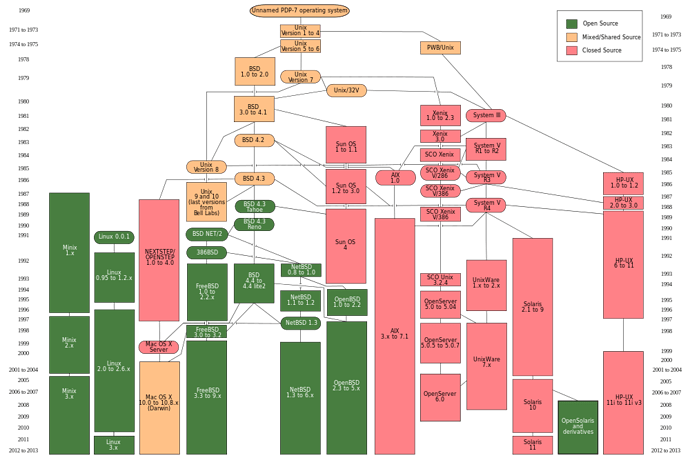Comments?
Well.. can't say Unix, since there are things there that are not.
Maybe go with Jon "maddog" Hall and say... "A Simple History of Linux-like Operating Systems"
Surely Unix-like as Linux is a late entrant.
Oh.. and HP-UX has never touched Svr4.. just saying.
Like AIX, as far as I know, both are Svr2 derivatives. While HP-UX did appear to have many things from the ill-fated Svr3, as far as I know, that really isn't the case.
Digital's Unix variants (there were multiple) are not shown... and they had great impact. DEC had a SVR variant, their Ultrix BSD variant and of course, one of the most successful deployments of of OSF/1 (all vendor variants not shown in the pic) which eventually became Digital Unix.
Mac OS/X isn't Unix at all and uses the (crummy) Mach kernel. Which, if you're going to show that, you might as well show all of the Mach based variants out there. And arguably if you're going to stray that far then QNX, etc... those types of things aren't out of the question.
Sigh.. this is actually a very hard thing to do. So.. IMHO, maybe just keep things to true Unix variants... even then the picture will still need some detail. But with OS/X, Linux, Minix and such removed, you'll have room for the missing things.
Also remember that for completeness, there are (very large) existing alternatives out there already as far as pictures go which do document the "Unix and Unix-like" OS's.
So.. pretty picture, but since it's not complete (nor accurate), people like myself and others will really pick this thing apart (don't put this into any textbook).
I see no reason to reject Linux. Functionally its extremely similar and obeys many standards. The reason it's not considered a UNIX is for legal reasons which are no longer relevant, now that UNIX isn't its own proprietary commercial product anymore. (Many UNIXes are. UNIX itself, the standard, is not.)
Things like OSX are a matter of opinion, but if Android is still considered Linux then OSX is still UNIX in my view. Mutated almost beyond recognition but there's still something there.
If we're to reject everything that's not descended from the One True UNIX then this list is going to be fairly scarce 
I believe PWB/UNIX was based on Version 7 (not version 1-4). If it wasn't based on V7, it certainly had significant input from V7.
SunOS 4 was not a dead end (as shown n the diagram). Solaris 2.0 (not shown in the diagram) was the result of a grand merge of SunOS 4 and UNIX System V Release 4. SunOS 4.1 (also not shown in the diagram) also contained significant input from UNIX SVR4 and was a major step towards Solaris 2.0 (containing SunOS 5.0), but /bin and /usr/bin utilities in SunOS 4.1 were still BSD based (with some SVR4 extensions) while /bin and /usr/bin utilities in Solaris 2.0/SunOS 5.0 were SVR4 based with BSD extensions.
Some BSD 4.4 features were also merged into SunOS 4.1 and Solaris 2.x, but that is not shown in the diagram.
I miss two things i worked with: Interactive Unix (386/ix) was a PC unix in the late 80s. If memory serves correctly it was a SysV variant. Then there was Apollo with their DomainOS, which was the first reliable high-availability cluster running Unix. IMHO it was built with the VAX-cluster in mind. Apollo Enterprises got bought (and within a few weeks destroyed) by HP in the nineties.
bakunin
DragonFly BSD developers and/or users might feel left out.
I take it that openindiana falls under OpenSolaris derivatives and one of the few remaining derivatives.
